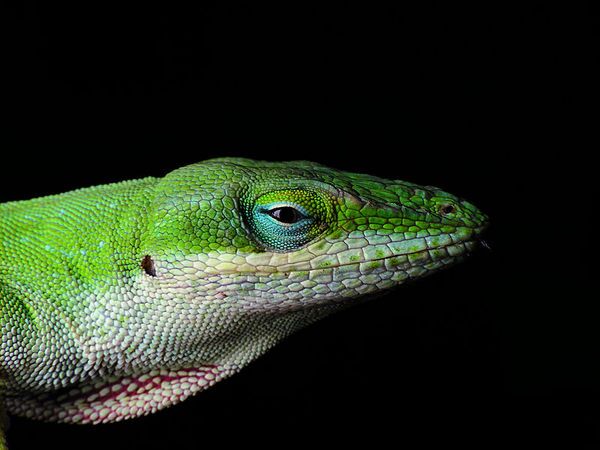Scientists Find New Lizard Population in L.A. Neighborhood

The fact that California holds undiscovered populations of wildlife is no surprise. Every few months, it seems, we hears about new species of lizards in desert springs, cave spiders in the Sierra Nevada, or hitherto unknown plant species just about anywhere in the state.
The lizards that biologists just found thriving in the Hancock Park neighborhood of Los Angeles aren't a new species: they're the extremely well-studied green anole. But as the Los Angeles County Natural History Museum's Lila Higgins reports, the discovery marks the first confirmed established population of the common reptile in Los Angeles County, and scientists are curious as to what effect the little lizards may be having on native wildlife.
Green anoles are native to the southeastern U.S. and nearby islands, where ironically they're in trouble due to competition from exotic reptiles. Hancock Park isn't the first beachhead green anoles have made in the state: a population has been established in San Diego's Balboa Park for many years, and reptile watchers also report a thriving colony of the sleek lizards in and around Temecula. Individual green anoles have been documented in places like Northridge and Chino Hills.
And according to Higgins, Hancock Park neighbors have told Natural History Museum herpetologist Greg Pauly that the anoles have been there as long as they can remember.
"In early October I headed out to the neighborhood," Pauly told Higgins. "We spotted our first anole as we took our first step up the driveway, and within 90 minutes, we observed nine anoles on both sides of the street across three large lots. We saw males, females, and juveniles so it was clear this was an established population. Further, a resident informed us she had been seeing the anoles for all 12 years she had spent in the neighborhood."
Green anoles have long been popular pets, and it's very likely that the Hancock Park colony got its start when a pregnant female or a pair of lizards either escaped or was "set free" by its former caretaker. It wasn't long ago that anoles were common sights in department store pet sections, being sold as "chameleons" due to their ability to change color from green to brown. They're still common pet trade reptiles, though they're more often found these days in specialty stores.
And that's a good thing, as they aren't particularly low-maintenance pets -- which may well be the reason the progenitors of the Hancock Park colony found themselves exploring the neighborhood's magnolia trees.
Aside from the obvious potential for competition with reptiles such as the western fence lizard that are native to Hancock Park, and adding one more predator to eat native insects like butterflies, Higgins points out that the anoles might well bear parasites and diseases that could jump to native lizard species.
The discovery, made as part of the Museum's Reptiles and Amphibians of Southern California (RASCals) citizen science project, offers an opportunity to study these and other possibilities as the anoles attempt to thrive in one of L.A.'s most affluent 'hoods.
And it also points out the importance of the burgeoning field of citizen science, which is even celebrated in song these days. Sometimes us locals can live with wildlife for decades before the career scientists ever learn it exists; connecting one group of wildlife lovers with the other benefits us all -- including the wildlife.





